RENEGADE GARDENER™
The lone voice of horticultural reason
The 2004 Renegade Gardener High Spot / Black Spot Awards
And now, the envelopes, please …
| High Spot Award 2004: The Death of the Cottage Garden Stick a perennial fork in ‘em—they’re done. 2004 clearly marked the year when yearning for a cottage garden—that passive surrender to the antiquated tastes of our English gardening forefathers—bit the compost, in favor of, well, anything else. Growing great gangly masses of perennials is no longer the American gardener’s raison d’etre. From newcomers to seasoned veterans, gardeners are realizing there’s more to a garden than flowers. Stone outcroppings, tall grasses, small trees, and shrubs, shrubs, shrubs are just a few of the items forming the foundation of today’s American garden. |
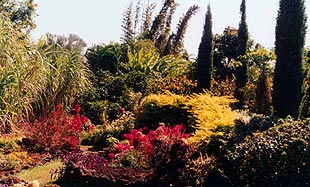 |
| From Honolulu, Hawaii … | |
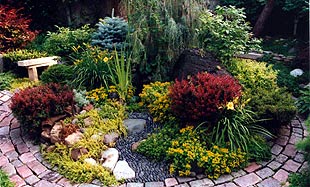 |
|
| … to St. Paul, Minnesota, gardeners are saying “no, thanks” to cottage gardens. |
Black Spot Award
Worst Plant Catalogue: Henry Field’s

Nothing wrong with their plants, just their astonishing decision to catalogue them with nary a mention of botanical names. Page after page, be it fruit, vegetable, perennial, tree or shrub, Henry Field’s lists them by common name ONLY. They’re afraid a little Latin will scare you off, thereby joining forces with a good portion of the American gardening industry that is convinced you have neither the time nor desire to actually learn anything about gardening. This continuing crusade to dumb-down American gardeners cannot be tolerated. In its pages, you will be introduced to Butterfly Plant, Silver Mound, Goblin Blanket Flower, Bachelor Button, Red Mexican Hat, and Golden Chain. My compliments to the photographer, Henry, the plants look lovely, but what the hell are they?
(For those readers uncertain about why this sets me off, review Tenet 4.)
High Spot Award
Best New Gardening Book: Perennials for Minnesota and Wisconsin
By Don Engebretson and Don Williamson
Just what northern gardeners need, whether they know it or not: an inexpensive, highly researched, wonderfully written and photographed book, telling you EVERYTHING you need to know about successfully growing the best perennials for USDA Zones 2-5. 86 genera; over 500 perennials in all.
Second Place: Stone Landscaping
By Don Engebretson with Lynn Steiner
The first and only how-to book on creating stone garden and landscape features that includes virtually every possible project, with excavation and preparation instructions according to USDA zone. Hundreds of photographs and drawings show exactly how to create your own patio, freestanding wall, pathway, pond, stream, outdoor kitchen, ruin, rock garden, water bowl, waterfall, retaining wall, garden edging, container space, and more. Complete information on selecting, purchasing, and working with stone. .
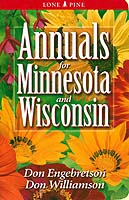 Third Place: Annuals for Minnesota and Wisconsin
Third Place: Annuals for Minnesota and Wisconsin
By Don Engebretson and Don Williamson
Everything you need to know about successfully growing the best annuals for USDA Zones 2-5. If you don’t own this book, you should buy it IMMEDIATELY.
Hey, what do you expect? It’s my site.
By the way, Trees and Shrubs for Minnesota and Wisconsin will be available in January.
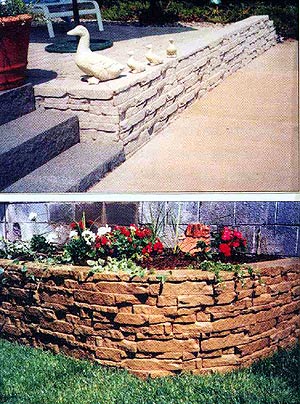 Black Spot Award
Black Spot Award
Almost the Worst New Gardening Product of the Year: Manitou Stone™ Retaining Wall System
First off, can they legally use the word “stone” when what they are selling is concrete? (How can you tell it’s concrete? By looking at it!) I mean, you can’t use the word “brick” unless your product is clay-based, and baked. Seriously. The American Brick Association doesn’t allow it, and for good reason.
What we have here is the next, next generation of concrete retaining wall block. Similar to all previous efforts, the product is made to vaguely approximate the look of natural stone. Instead of tumbling it, they cast it. The funny thing is, you need to install it just like natural stone—level and tamp the base, cut units with a masonry saw to make corners, etc. And the units aren’t going to be noticeably lighter than most stone types. I guess the advantage is, when you’re done, you have a semi-cheesy looking concrete wall, instead of a beautiful stonewall. Up to you, I guess. By the way, the ducks are extra.
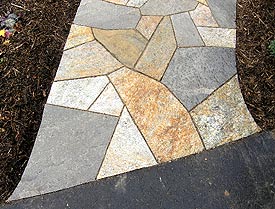 |
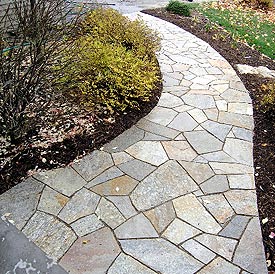 |
High Spot Award
Stone of the Year: Rocky Mountain Quartzite Gold
I’ve long been a fan of Rocky Mountain quartzite silver, using it extensively in sidewalk and entryway projects around the Twin Cities. Silver tends to give you two color hues, a predominantly silver tone with gray flecks, and a gray tone with silver flecks. Used in a shady area, it’s magnificent, and in moonlight it positively glows.
Then this summer, I used RMQ gold for the first time, in this sidewalk installation in Woodbury, and was amazed at the stunning effect created by the five or six different color hues. It’s like a glossy Chilton stone. Subtle washes of silver, purple, blue, gray, green, rust and yes, gold, are present as you pick through the stone slabs comprising a single pallet.
Widths range from one to one-and-a-half inches, with most pieces evenly flat on both sides. Because it’s a quartzite, it’s very dense and heavy, making it a suitable choice for either mortared or dry-laid sidewalks, container spaces, and patios. It’s also one of the least expensive stones per square foot on the market. The only downside is, the stone often doesn’t break cleanly with a Hydra-Splitter, even with light scoring. You need to score deeply both sides of a piece with a diamond blade, then use a Hydra-Splitter, or snap it using the old 1/4” board and hammer trick, all of which makes installation a bit more work.
Rocky Mountain quartzite gold (and silver) is available to comrades lucky enough to live in Minnesota at Hedberg Landscape Supply in Plymouth; elsewhere across the northern US and in Canada, ask for it by name at your large landscape supply yards.
Black Spot Award
Fibbing in a Press Release: TulipWorld.com
TulipWorld is a Dutch outfit that sells organically grown bulbs. Nothing wrong with that. In fact, their bulbs rock. But a statement in their July 30, 2004 press release didn’t pass the smell test.
I didn’t object too heartily to an initial statement, “Buying organic flower bulbs means that you support an environmentally friendly process that does not pollute.” I could be snide, of course, and argue that if the bulbs were inexpensive, buying them would mean nothing more than that I support spending less on bulbs. I could also point out that no matter what brand of organic fertilizer used on the bulbs, it didn’t go from being fish heads or sea kelp or cow manure or iron deposits to the little flakes and granules applied to the soil via the waving of some magic wand. There’s processing involved, and at some point in the equation, fossil fuels were burned. But I digress.
What gets the gong is a follow-up statement, “Organic bulbs are also stronger since they are grown without the use of chemical fertilizers.” First, all organic fertilizers are “chemical” fertilizers. What they meant to say was, “without the use of synthetic fertilizers.”
Second, if comparing bulbs grown without any fertilizer—a form of organic growing—versus bulbs aided by synthetic fertilizers, the latter would be larger and more robust. Assuming they mean their bulbs are fertilized with organic fertilizers, again, it’s no, that’s not going to make them better bulbs compared to bulbs aided by synthetics. You can grow anything as well with organic fertilizers as with synthetic fertilizers—I do—but stating that a bulb is going to be “stronger” (and by that I assume they mean bigger and/or more vibrant) because only organic fertilizers were used goes against scientific fact. Repeat after me: nitrogen is nitrogen, phosphorus is phosphorus …
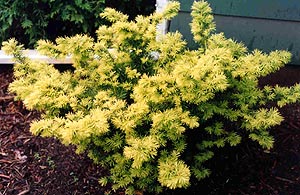 High Spot Award
High Spot Award
Shrub of the Year: Taxus cuspidata ‘Nana Aurescens’
No question in my mind that the darling Nana is the 2004 MVP of the shrub world. This magnificent spreading yew brings sunny yellow foliage into the darker corners of the landscape, and retains it until well into fall. The shrub performs best in part shade, with a mature height of 5’ and equal spread. Reliably hardy to Zone 4.
 High Spot Award
High Spot Award
Perennial of the Year: Calamagrostis x acutiflora ‘Avalanche’
Gardeners who have fallen in love with C. x acutiflora ‘Karl Foerster’ (meaning everyone who grows it) have embraced ‘Avalanche’—essentially a variegated ‘KF’—with equal affection. This very recent introduction has mistakenly been listed in some plant references as hardy only to Zone 5, but that’s not the case. With proper growing practices and winter mulching, the plant is hardy to Zone 4.
Grow ‘Avalanche’ in full sun, keep the soil around it moist and mulched during the growing season (a medium watering twice a week, essentially) and you will be rewarded with a 3-4’ tall, slightly arching clump of narrow leaves featuring green edges with white center stripes. In early summer, erect flower stalks burst high to 5’ carrying feathery, purple-green flowers that turn gold as the season progresses.
There have been reports of rust during especially rainy growing seasons, but in most Zone 4 summers the plant will remain problem-free.
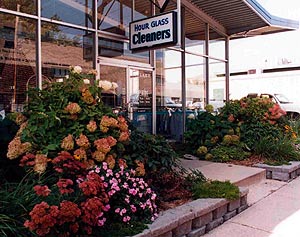 |
| Hour Glass Cleaners, Excelsior, Minnesota |
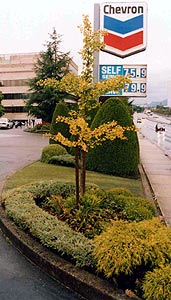 |
High Spot Award
Best Gardening Trend: Commercial Businesses with Real Landscaping
I’m not so sure the commercial landscaping industry has awakened to any degree, judging from the number of new commercial landscaping jobs I spot that promulgate cookie-cutter, potentilla-in-a-gravel-bed, god-awful landscaping. But a few business owners are obviously rising from their slumber.
Real landscaping—meaning a mixture of small trees, more than two shrub varieties, some perennials and annuals—is beginning to sprout up around corporate office complexes and retail stores across the frozen tundras of zones 2-4. And man, do those businesses stand out. As more business owners start to realize that bad landscaping (a “decorative” rock bed sporting a forty-foot single row of Stella de Oro daylilies in front of a forty-foot row of globe arborvitae, for instance) goes virtually unnoticed by the public (particularly after several years, as the plants begin to die off), while a creative and cared-for landscape adds value to their properties and puts smiles on the faces of their customers, we might actually get to the point where commercial landscaping is no longer a rip-off and a joke.
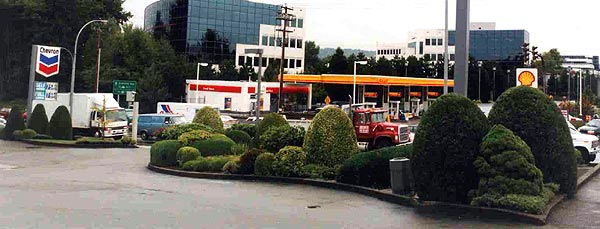 |
|
|
Black Spot Award
Worst New Gardening Product of the Year: Synthetic Turf (as Lawn Alternative)
The safest, most economical, and best-looking surface for a residential or public play area? Synthetic turf atop rubber padding, of course. Hankering for a low-maintenance putting green in the back yard? Synthetic turf is the only way to go. Just purchased a ratty motel and can’t yet afford flagstone for high-traffic pathways? I’ll even let you install synthetic turf in this scenario.
But this summer’s press release touting synthetic turf as a viable alternative to residential yards went straight into the 2004 Black Spot Award file. A Minnesota company that distributes a popular brand of plastic grass has started pitching it to consumers as a viable alternative to lawns.
“The perfect solution for shady back yards and other areas where grass won’t grow” they state in their release and brochure. “The turf is constructed to allow water to pass through but stop weeds and unwanted plant life. Say goodbye to mowing, watering, and fertilizing.”
And say hello to the outskirts of hell. I love the “unwanted plant life” part; I can see why it would be important not to have any real plants growing up out of your damn plastic grass. America, allow me to let you in on a little secret, YOU DO NOT NEED TO HAVE LAWN ON ALL FOUR SIDES OF YOUR HOUSE. If the day comes when Americans are so devoutly determined to have a damn lawn where grass won’t grow that they start installing synthetic turf anywhere around their homes, I’m out of here. I’m serious—I will realize I have lost, I will quit this ridiculous garden writing pipe dream, and will move on to writing what all garden writers secretly yearn to write: romance novels.
This concludes the 2004 Renegade Gardener High Spot/Black Spot Awards. If you are visiting this site for the first time, bi-monthly (give a week or two) updates of this, the Current Column, plus the top four feature buttons to the left, commence May 1 each year, and continue through October. November through April, this site hunkers down into the topsoil of the worldwide web like a European sawfly, until the warmth of spring triggers its voracious return.
Until then, take a tour through the hundreds of archived photo essays, articles, and features. Over the years I’ve received e-mails from thousands of visitors telling me they have wasted countless hours perusing this site, for when it comes to helpful, free gardening information, you’ll find no better combination of precise university research and blatant horticultural heresy than right here at RenegadeGardener.com.
I’m in town most of this winter, so if you’ve stumbled onto my site and wish to comment or say hello, feel free to shoot me an e-mail. If not, I’ll see you in the spring.
Don Engebretson
The Renegade Gardener
- The 2018 Renegade Gardener High Spot/Black Spot Awards January 5, 2019
- The 2017 Renegade Gardener High Spot/Black Spot Awards January 1, 2018
- The 2016 Renegade Gardener High Spot/Black Spot Awards January 1, 2017
- The 2015 Renegade Gardener High Spot/Black Spot Awards January 1, 2016
- The 2014 Renegade Gardener High Spot/Black Spot Awards January 7, 2015
- The 2013 Renegade Gardener High Spot/Black Spot Awards January 1, 2014
- The 2012 Renegade Gardener High Spot/Black Spot Awards January 4, 2013
- The 2011 Renegade Gardener High Spot/Black Spot Awards January 1, 2012
- The 2010 Renegade Gardener High Spot/Black Spot Awards January 1, 2011
- The 2009 Renegade Gardener High Spot/Black Spot Awards January 1, 2010
- The 2008 Renegade Gardener High Spot/Black Spot Awards January 1, 2009
- The 2007 Renegade Gardener High Spot/Black Spot Awards January 3, 2008
- The 2006 Renegade Gardener High Spot/Black Spot Awards December 20, 2006
- The 2005 Renegade Gardener High Spot/Black Spot Awards December 9, 2005
- The 2004 Renegade Gardener High Spot/Black Spot Awards January 1, 2005
- The 2003 Renegade Gardener High Spot/Black Spot Awards November 19, 2003
- The 2002 Renegade Gardener High Spot/Black Spot Awards October 31, 2002
- The 2001 Renegade Gardener High Spot/Black Spot Awards October 16, 2001
- The 2000 Renegade Gardener High Spot/Black Spot Awards October 20, 2000